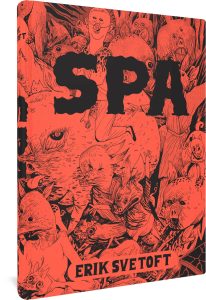 Spa by Erik Svetoft
Spa by Erik Svetoft
Writer/Artist: Erik Svetoft
Translator: Melissa Bowers
Publisher: Fantagraphic Books
Publication Date: February 2023
I have nightmares. Not clinically often, but frequently enough that I try to slow them down; no caffeine or spicy food before bed and definitely no horror movies after the sun goes down. While I can’t say I’ve been great about the no caffeine or spicy food, avoiding horror movies at night has been something I haven’t broken in years. Reading never seems to bother me though. Even though comics are also visual and that seems to be what triggers the nightmares, I can stick through Junji Ito or reprints of Tales of the Crypt well into the evening. It wasn’t until I read Spa by Eric Svetoft and translated from the Swedish by Melissa Bowers, that a book actually gave me nightmares.
I don’t want to oversell this, especially to those who consume horror voraciously. I’m easily spooked. Things make me afraid. If my kid comes around the corner too fast, I jump. So, don’t be running to Svetoft to see the horrific like you’ve never seen before. This isn’t that book. Instead, what really frightened me out about the book and stuck with me into my dreams, was the way Svetoft coupled his visuals with the absolute terror of the characters’ indifference.
The art in the book leans towards the cartoonish in the beginning, although this changes later on as the spa gets weirder and weirder, and we are immediately set up with the uncanny. From the first image, we are presented with a smiling character staring directly at the reader. This is not an unusual strategy in and of itself. Plenty of comics and movies make characters stare at the reader in an attempt to bring us in, seduce us into following the thrill or the action more intensely. Various creators do it to various levels of success, but it typically falls into breaking the fourth wall or the reader as stand in for another character/place/villain/hero/being/thing.
In Spawe often have no idea what the characters are looking at. This first image is a distinct exception because we do get the awkwardly faced monsters, who stretch the argument about the smiley face being universal to its furthest point, on the other end of the character’s gaze. Or do we? That third panel has the monsters framing the character’s body, and therefore gaze, which makes the reader the center. So, before the first two pages are over, the reader is stared at, comforted into thinking it’s these monsters being stared at, then questions whether the character is staring at another monster or the reader. Maybe a bit of both?
This eerie looking that Svetoft has many of the characters engage in, continues for the first half of the book. Before we get to the owner spa, the dead are looking at us. When we get to the spa, the residents are looking at us in a visual delivery of a welcome video. Then as the panels take us through the various spaces in the spa itself, more characters make eye contact. The eyes are always looking at the reader. They are always gazing through the page right where we are sitting. They don’t let go until you turn the page to new sets of eyes doing the same. There’s no escape.
In a movie, there would be a character who was standing in for the viewer who is being stared at. The terror would be in the making that character feel uncomfortable, therefore us uncomfortable. But the beauty of Svetoft’s work being in comics is that there isn’t a stand-in character. Maybe, for some of us, we invent one or assume one of the characters introduced is experiencing the gaze. It can’t be us. Not us. Though, it is so clearly us. This strategy pulls the reader in a way that is unique to comics and, maybe, some art-house films. There’s terror here but not that jump-from-behind-a-corner-kind. It’s the kind of fear that lurks beneath the surface and seeps in when you least expect it. When the shadows move unexpectedly. When you find an earworm where you just killed an earworm. When the mold has spread suddenly in the night.
The terror of the images gets a bit more concrete once half the book is over. The actual mold inside the spa itself and the hoard of pigs coming around the corner are surreal and odd, but mostly in a darkly comedic way. Nothing truly matches the sheer terror of the eyes. It isn’t just those blank stars that got me though. It was the coupling with the rules of the universe Svetoft has created. This world is so close to our own yet two spaces to the left. Just in the periphery. Not far enough away to be comfortingly unreal but distant enough to feel possible.
I’d like to tell you what “happens”, but this book isn’t really about that. The back of the book gives enough of the plot: It’s a story of a spa for wealthy people that gets increasingly more infested with mold until it all breaks down. That’s really it. I encourage you not to avoid it because of its uncomplicated narrative. The simplicity of events and the lack of details causing some confusion is the narrative. Leaning into it makes it more enjoyable.
Whether you like the Director seeing weird, cute creatures in every painting, two plumbers not being able to fix problems potentially making them worse, the guy with the pig nose as punishment, or the chef taking over a wealthy client’s life, there’s something absurdly delicious for you to experience in this book. The book doesn’t shy away from making deeply satirical comments about the wealthy and the industries that pop up to cater to them. Quickly, you’ll realize that the banality of the characters is part of their own indifference to things that truly matter. Their pure belief that they are untouchable. There’s a slight linearity to the events but once Svetoft’s teeth are in, you’re going along for the ride no matter how much these characters make your eyes or stomach roll.
The surrealism of this book is complicated, layered, and satirical. Nothing here is super on the nose. The book respects its reader’s ability to follow along and find the comedy (centipede monster giving a little kiss to the Director) inside of the absurdity (man can’t find his way to his room if he even has a room). There’s no hand holding. Only the unfolding events seem objectively observed.
This is where the terror can really take hold. Sure the gazes linger with you long after you’ve put down the book, but so do the events. Bodies easily disposed of, boardrooms of corpses, a harpoon wielding guest just not commented on. It’s as normal as the front desk clerk getting into a fight with her sister and then being screamed at by HR for taking a personal call. It’s all surreally too real. Which, much like the book, doesn’t make much sense but what in this world makes a lot of sense anymore? Honestly, a hoard of pigs riding through a mold infested spa catering to the wealthy sounds like a Tuesday news story buried behind seven pages of more real-world absurdity.
This comic doesn’t hold back. It criticizes and skewers and pokes fun. It is terrifying. It feels real. It also has so much fun doing it. All the images and dialogue and design show Erik Svetoft is having an absolute blast; the blowing things up definition and the pure euphoria at the same time. If you can let yourself get swept into it, then you can ask for no better guide than Svetoft. What he wants to show you is terrible and awful, but you have to laugh at it. You have to laugh deeply whispering, “What the f*$%” into your pillow as you fall asleep. Your nightmares are the only place where it all starts to make sense.
Read more great reviews from The Beat!



